In brief
- Despite its growth in 2020, Bitcoin search interest remains lower than in 2017.
- The number of Bitcoin ATMs is growing faster than ever before in the US.
- Bitcoin reached its highest ever value in December 2020, following more than six months of growth.
2020 has certainly been a memorable year, with the coronavirus sending the world into lockdown and setting countries' economies teetering.
For the cryptocurrency industry, the past year has seen a surge in institutional adoption of crypto, and the dramatic emergence of the DeFi industry.
But once again, Bitcoin has stolen the spotlight this year; smashing records, securing adoption by major firms, and reigniting the ambitions of blockchain developers around the world.
As 2020 draws to a close, we take a look back at Bitcoin by the numbers, to see just how things have progressed in the last year.
Global search interest
The number of search engine queries for a given cryptocurrency is often considered to be a good proxy for absolute interest in that cryptocurrency—or the crypto market in general.
According to data from Google Trends, worldwide search interest for Bitcoin increased from 45 in January up to a peak of 100 last month. Despite this, however, Google search volume remains less than a quarter of its highest ever volume, which was achieved in January 2018.

Nigeria, South Africa, Australia, Switzerland, and Ghana were the top five regions by Bitcoin search volume this year.

The most popular related queries this year were "price bitcoin", "kurs bitcoin", "bitcoin usd", "bitcoin stock", and "bitcoin usd price" respectively—with "price bitcoin" being more popular than the next four most commonly searched items combined.
Engagements surrounding Bitcoin also climbed on Reddit in 2020. with the /r/bitcoin subreddit breaking through the 1.8 million subscriber mark in December 2020—up from 1.2 million in the previous year. Likewise, the number of comments on the subreddit has more than doubled since the start of the year, achieving roughly 20x the number of comments per day as the /r/ethereum subreddit.
Academia
Academic interest surrounding Bitcoin and blockchain technology, in general, has grown considerably in 2020 when measured by the number of mentions in academic papers.
The number of Google Scholar articles mentioning Bitcoin reached a total of 97,800—15,800 of which were published in 2020. Comparatively, the number referencing blockchain now stands at 205,000 as of December 2020, of which 33,800 were published this year.
To put this into perspective, there were just 371 Bitcoin mentions and 140 blockchain mentions respectively in scholarly papers in 2009.
Moreover, the number of Bitcoin mentions in the Cryptology ePrint archive—which is used to archive papers related to cryptology—continues to grow at a rapid rate. A total of 20 new papers mentioning Bitcoin have been added so far in 2020, increasing the total to 166 papers.
However, 2018 remains the peak year for Cryptology ePrint papers mentioning Bitcoin, with a total of 26 published that year.
Development
According to data from CryptoMiso, Bitcoin is the third most active cryptocurrency by development activity—as measured by the number of commits to the asset's most popular Github repo.
Just two cryptocurrencies are more active: Chainlink (LINK) and Lisk (LSK)—the former is a blockchain-based oracle network, while the latter is a platform for launching decentralized applications (dapps).
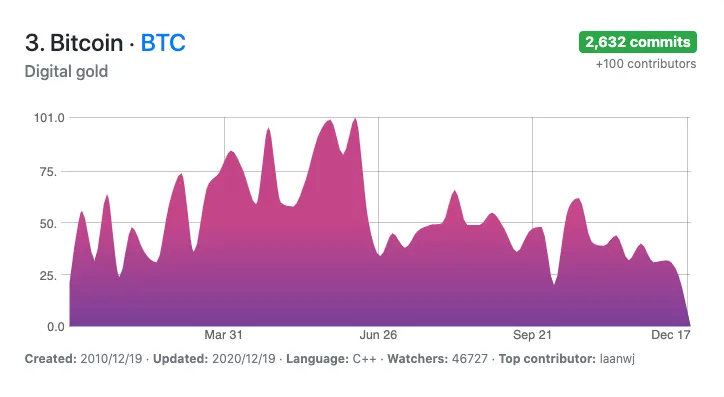
Bitcoin's Github repo now has a total of 2,632 commits from more than 100 contributors, compared to 3,592 commits (62 contributors) for Chainlink and 3,453 (63 contributors) for Lisk.
Despite this, Bitcoin currently leads the way by a significant margin in terms of the number of stars and watchers—which essentially means more people follow Bitcoin’s repo than any other cryptocurrency.
Bitcoin market cap and dominance
2020 has been one of the strongest years on record for Bitcoin, with the cryptocurrency reaching its highest ever value this year at just north of $24,000. At the same time, its market capitalization spiked to an all-time high of $450 billion—exceeding its 2017 peak by more than a third. Bitcoin's market cap actually surpassed its all-time high before its price reached its own all-time high, chiefly because there are more Bitcoin in circulation than there were at the time of its previous all-time high.
Bitcoin's surge may have been largely capitalized by a recovering stock market, and a surge of institutional investments throughout the year—with funds like Grayscale and Square adding significant sums of BTC to their coffers.
Throughout 2020, Bitcoin has seen its market dominance fluctuate considerably. As per data from CoinMarketCap, Bitcoin's market dominance has ranged between 56% and 69% throughout 2020. It lost significant ground against altcoins from January until September, but has since picked up much of its losses.
"Altcoins performed very well in 2020 and Bitcoin dominance fell 5% YTD," said Ivan Liljeqvist, host of the Ivan On Tech Youtube channel. "This may only be the beginning as altcoins will probably outperform Bitcoin even more in 2021. I expect the Bitcoin dominance to fall below 40% next year just like it did in 2018."
Transactions
Bitcoin’s transaction fees have been a point of contention for several years now, after they reached an average of more than $55 per transaction in December 2019—essentially rendering the cryptocurrency useless for microtransactions at the time.
Things have improved a great deal since then, and the average Bitcoin transaction fee has been under $2 throughout much of 2020.
This can be attributed to the increased use of transaction batching by cryptocurrency exchanges, and the growing use of SegWit addresses—which benefit from reduced transaction fees.
The number of confirmed Bitcoin transactions per day has increased slightly YTD, but has varied considerably throughout the year—reaching a peak of 330,000/day in March and a low of 264,000/day in April (likely as a result of Black Thursday).
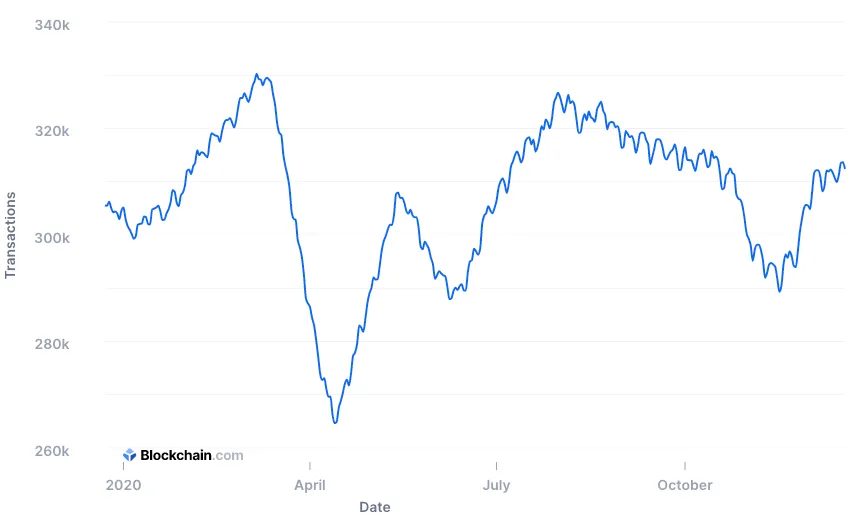
Though the number of on-chain transactions has varied throughout the year, the total value of on-chain transactions has been on a near-constant uptrend this year—climbing from $730 million/day on January 01, to $3.4 billion/day on December 18—its highest value since January 2018.
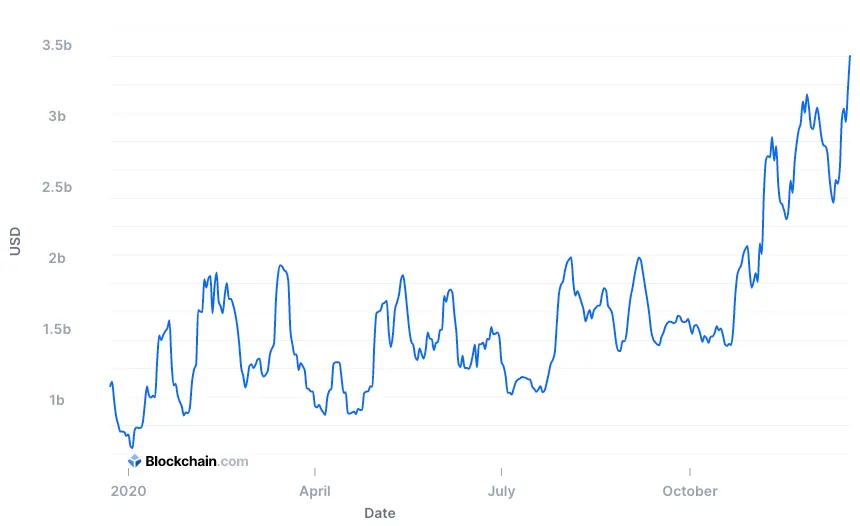
Despite an increase in the number of on-chain transfers, the average transaction fee has rarely broken above $10 in 2020.
Trading
With Bitcoin’s growing value has also come increased trading activity this year—which also reached its highest ever value in 2020.
As per data from Messari, Bitcoin's real on-chain trading volume surpassed its 2017 monthly peak of $88.5 billion in November this year, when it achieved $114 billion in trading volume. Messari’s data only considers trading volume data from the top ten reputable exchanges, as identified by Bitwise investments.
"Bitcoin's parabolic rise of over 170% in 2020 has solidified both Bitcoin and the entire crypto market as an asset class that the largest global institutions have added to their portfolios," Todd Crosland, CEO of CoinZoom, told Decrypt. "As global currencies lose value, Bitcoin will continue to rise. 2021 could easily see Bitcoin reaching $25,000 to $30,000."

This value is around 9x lower than the reported trading volume, which may come from exchanges that artificially inflate their trading volume to appear more attractive, or simply report unreliable data.
The number of Bitcoin ATMs available also increased considerably throughout 2020—and is increasing at its fastest ever rate. In total, there are now at least 13,400 Bitcoin ATMs available worldwide, up from 6,039 a year ago, and 460 five years ago, as per data from coin ATM radar.
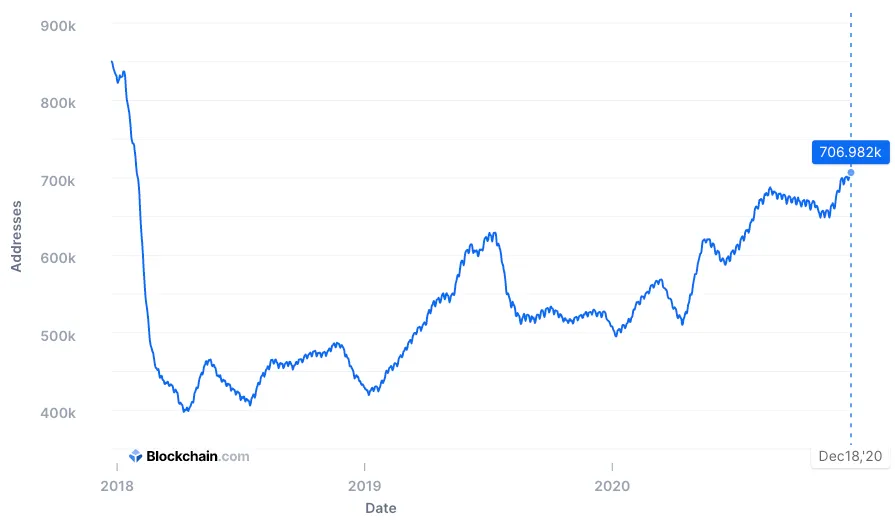
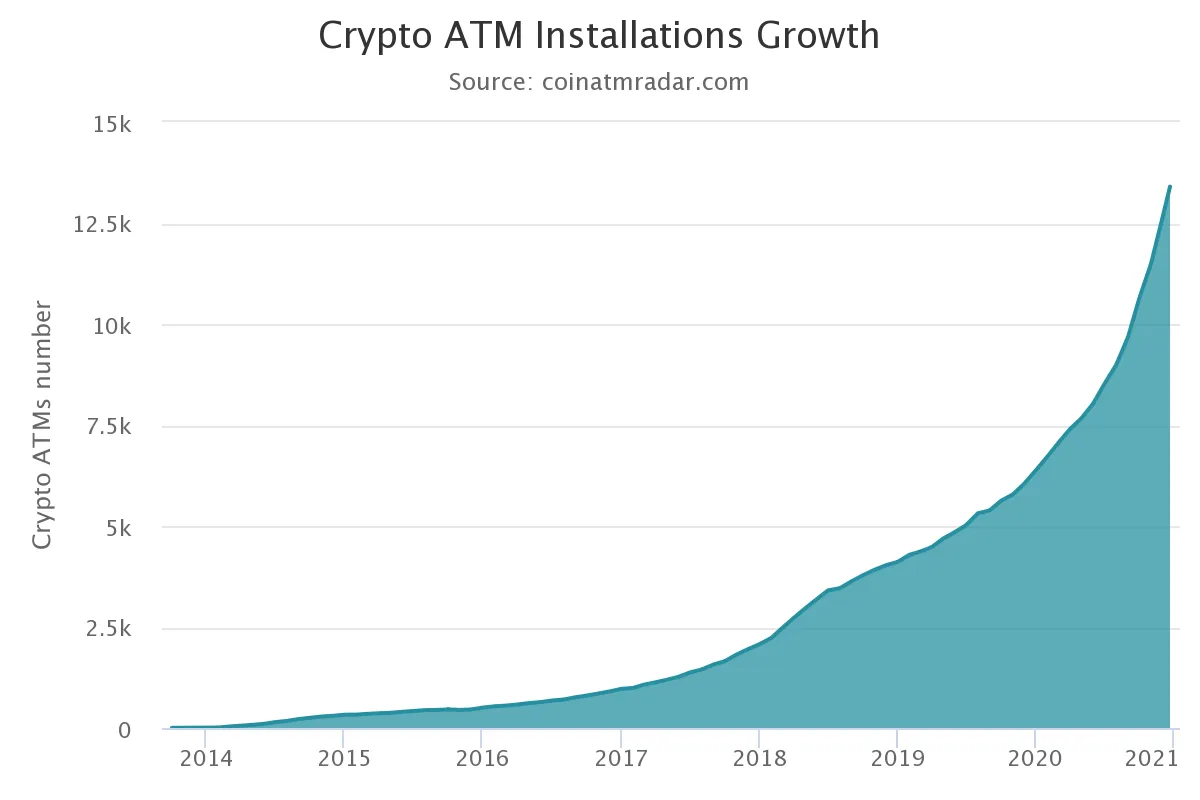
Of these ATMs, the vast majority are located in the United States, with 10,848 ATMs in the US alone, whereas Europe has only seen the number of Bitcoin ATMs available increase slightly since 2019—climbing from 943 to 1,251 in the last two years.
This difference may be explained by the reduced availability of online cryptocurrency exchanges in the US, forcing residents to resort to alternatives like Bitcoin ATMs.
Addresses
As you might expect, with increased value and increased trading activity, the number of active Bitcoin addresses per day also increased significantly throughout 2020—but failed to break the record set in December 2017.
The number of unique addresses increased from around 480,000 at the start of the year to over 700,000 at its peak in early December.

Alongside this increase in activity, the number of Bitcoin millionaires also soared. As per data from BitInfoCharts, there are now more than 67,000 Bitcoin millionaires—up from just 25,000 a month ago.
Nonetheless, the vast majority of Bitcoin addresses still contain between 0.001 and 0.01 BTC, while just 1.7% of addresses hold 1 BTC or more. As of December 2020, you’ll need to hold somewhere between 1 to 10 BTC to be part of the top 1% club.
Lightning Network
The Lightning Network has long been hailed as the solution to both Bitcoin’s scaling woes and the high fees that can occur when the network struggles to handle its transaction load.
Since the first Lightning Network mainnet product launched in early 2018, the number of nodes and channels operating on the network has mostly increased—with a small decline between mid-to-late 2019.
The total number of Lighting Network nodes increased from 4,923 in January to an all-time peak of over 8,000 in December, representing growth of more than 60% in a year. Likewise, the total capacity of the network—as measured by the sum capacity of all channels—has climbed almost parabolically since March, and currently sits at over $24.7 million.
The number of Lightning Network channels achieved slower growth in 2020, climbing from 27,929 in January to 33,483 by December 19—equivalent to growth of almost 20%.
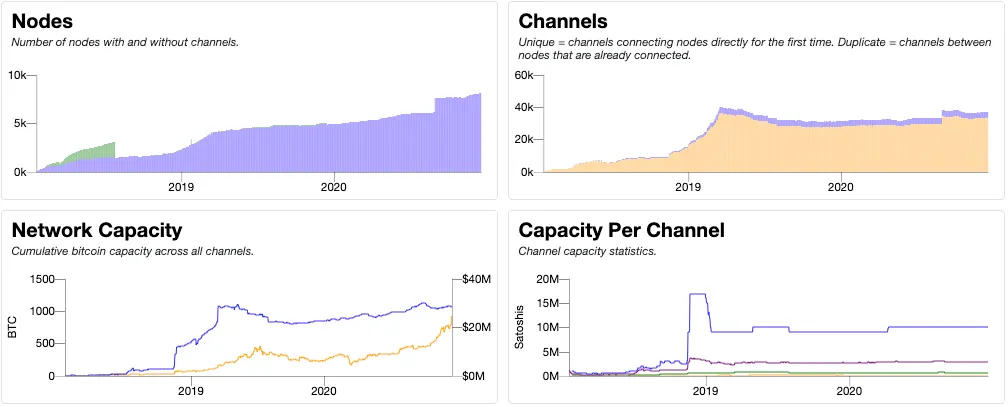
Business adoption of the Lightning Network also picked up in 2020. Bitfinex—one of the first exchanges to support the Lightning Network—added support for wumbo channels, allowing users to deposit larger amounts of BTC using the solution. Likewise, Kraken announced plans to add Lightning support in early 2021.
Despite this growth, the Lightning Network continues to struggle with centralization, as the majority of Bitcoin available on the network is controlled by a small fraction of the nodes. "About 10% of the nodes control about 80% of the network as of the beginning of the year," said Vid Gradisar, CEO of NewsCrypto.
Bitcoin DeFi
Although the blossoming decentralized finance (DeFi) industry is primarily associated with the Ethereum ecosystem, a number of projects have launched in recent years that help bring BTC to other blockchains as either a synthetic asset or wrapped token.
By far the most popular of these is Wrapped BTC (WBTC), an ERC-20 token backed by Bitcoin. As an ERC-20 token, WBTC can be used with a wide range of Ethereum-based DeFi protocols—such as Uniswap and Compound. This is currently its primary use-case.
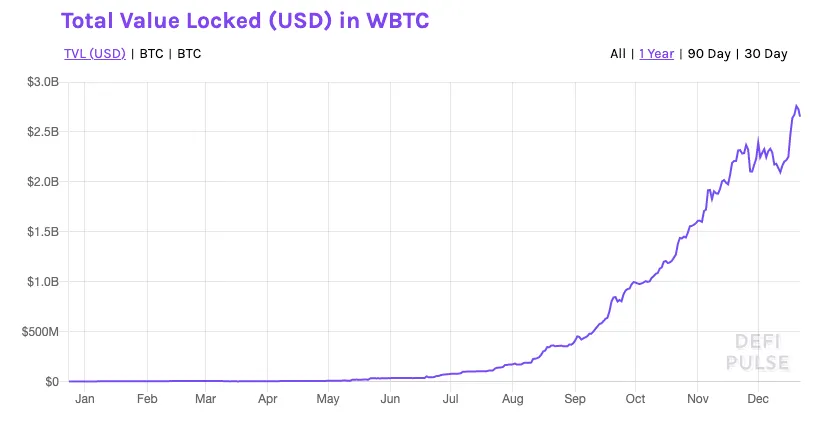
In the last year, the number of BTC wrapped as WBTC has multiplied by more than 4,000%—spiking from just $4.3 million worth of BTC in January 2020 to a peak of almost $2.8 billion in December.
"This is mostly driven by the growth of DeFi and Uniswap," Ivo Georgiev, CEO of AdEx Network, told Decrypt. "While WBTC is mostly custodial, there are exciting advancements such as tBTC by Keep project that pave the way towards trust-minimized Bitcoin lending and borrowing."
As per data from Dune Analytics, WBTC currently holds an 80.4% share of the tokenized BTC market, with renBTC the nearest competitor at 11.9%.
Bitcoin mining in 2020
As in previous years, the Bitcoin hash rate reached successive all-time highs in 2020, beginning the year at just over 100 exahashes per second (EH/s), before climbing to its highest-ever value of 157.6 EH/s in October.
Since Bitcoin's value has grown faster than network difficulty and hash rate, Bitcoin mining profitability has increased throughout 2020—reaching a peak of $0.2 USD/day/TH/s, up from $0.155 at the start of the year.
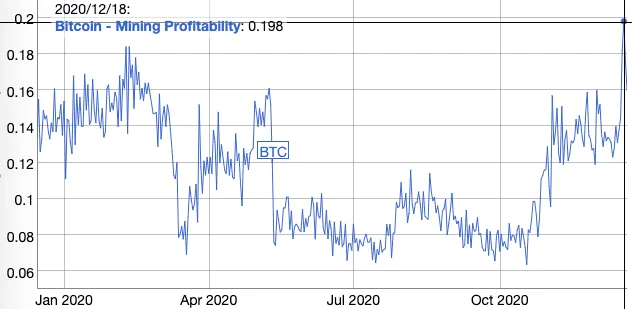
“The Bitcoin hash rate exploded in 2020, we saw an increase from around 100 Exahashes to 150+ exahashes—an extremely impressive rate of growth,” Alejandro De La Torre, VP at Poolin told Decrypt. “This means that confidence in Bitcoin is unbelievably strong. Miners are expanding and setting up new infrastructure, which in turn secures the bitcoin network for everyone in the bitcoin ecosystem.”
As reported earlier in the year, China still contributes the majority of the Bitcoin hash rate, with a 65% share of the total hash rate in December 2020. The United States, Russia, and Kazakhstan are 2nd, 3rd, and 4th in line, contributing 6-7% apiece. This dominance is likely the result of China's better access to mining equipment and low energy costs—since the majority of major ASIC manufacturers are located in Asia.
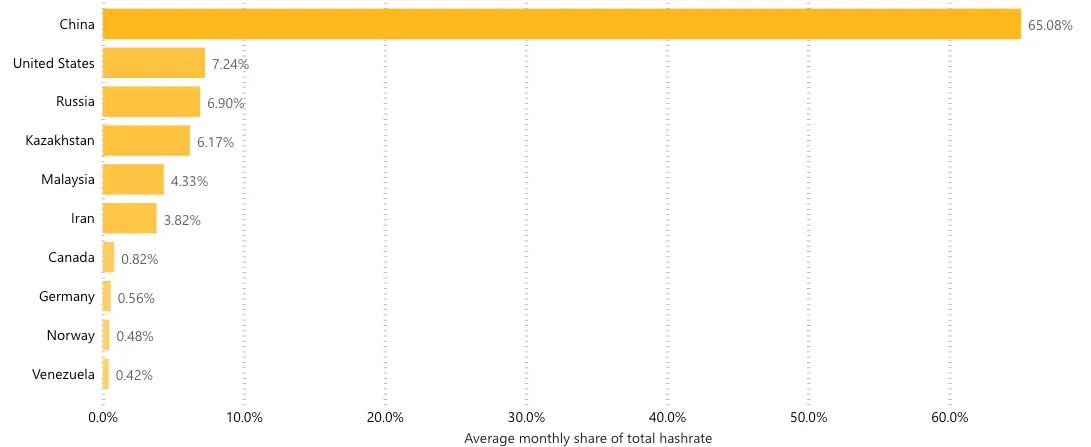
The distribution of hash rate between the different mining pools has varied considerably throughout the year, but several key points have been observed: BTC.com has seen its hash rate share collapse since the middle of the year; Huobi Pool has grown in popularity; and both Poolin and F2POOL have roughly maintained their hash rate share.
In summary
2020 has been a year of highs for Bitcoin; it has witnessed one of the most dramatic recoveries in its short history, climbing from the low $5,000s to a peak of over $24,000 this year.
Fueled by rampant interest among institutions, investment funds, and retail investors, Bitcoin has smashed record after record in these last 12 months and looks set to end the year on a high note.
Bitcoin now moves into its twelfth year of existence with the chance to become the first viable alternative to fiat currency—albeit with a few obstacles to overcome first.

